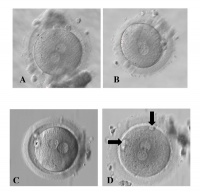User:Z3289738
Lab Attendance
Lab 1: --Z3289738 11:49, 25 July 2012 (EST)
Lab 2: --Z3289738 10:12, 1 August 2012 (EST)
Lab 3: --Z3289738 10:08, 8 August 2012 (EST)
Individual Assessments
Lab 1
Q1. Identify the origin of In Vitro Fertilization and the 2010 nobel prize winner associated with this technique and add a correctly formatted link to the Nobel page.
The idea of In Vitro Fertilization began to formulate in the 1890s, when Walter Heape reported the first known case of embryo transplantation in rabbits. In 1953 John Rock extracted the first intact human fertilized egg. The first successful attempt at IVF was in 1978 by Steptoe and Edward.
Robert G. Edwards, the physiologist who developed the In Vitro Fertilization treatment, was awarded the Nobel Prize in Physiology or Medicine in 2010. Nobel Prize Page
Q2. Identify and add a PubMed reference link to a recent paper on fertilization and describe its key findings (1-2 paragraphs).
This article looks into the process of embryo implantation. It demonstrates how the activation of the epithelial Na(+) channel triggers prostoglandin E(2) release,phosphorylation of teh transcription factor CREB and upregulation of cyclooxygenase 2, the enzyme required for prostaglandin production and implantation. They detected maximum Epithelial Na(+) channel activation at the time of implantation in mice, and that blocking or knocking down this channel in mice resulted in failure to implant. These results indicate the importance of the Epithelial Na(+) Channel in the process of implantation, and the consequences of defects such as miscarriage and low success rates in IVF.
<pubmed> 22729284</pubmed>
Lab 2
Q1. Upload an image from a journal source relating to fertilization or the first 2 weeks of development as demonstrated in the practical class. Including in the image “Summary” window: An image name as a section heading, Any further description of what the image shows, A subsection labeled “Reference” and under this the original image source, appropriate reference and all copyright information and finally a template indicating that this is a student image.
Q2. Identify a protein associated with the implantation process, including a brief description of the protein's role (1-2 paragraphs)
Trophinin
Trophinin is an membrane adhesive protein expressed on human trophoblastic cells and on uterine endometrium epithelial cells. The protein mediates apical cell adhesion and activate trophectoderm cells for implantation via proliferation and invasion. [1]
Lab 3
Q1. Identify the difference between "gestational age" and "post-fertilisation age" and explain why clinically "gestational age" is used in describing human development.
"Gestational age" is measured from the first day of the woman's last menstrual cycle, whereas "post-fertilisation age" measures the time passed since fertilization of the oocyte. Gestational age is more clinically relevant as it is easier to determine the date of the woman's last menstrual cycle than it is to determine the date of fertilization. Furthermore, gestational age can also be determined before and after birth by measuring the size of the head, thigh bone and abdomen (before birth), and the size of the head and weight after birth. Gestational age is therefore used to determine the infant's medical history and medical plan.
Q2. Identify using histological descriptions at least 3 different types of tissues formed from somites.
References
- ↑ <pubmed>17487845</pubmed>
